
Choosing A Bird Cage For Bigger Birds
It is quite common to walk into a pet store and see many smaller bird cages made from plastic or thin metal. Such cages are quite inexpensive and give a potential new bird owner the idea that purchasing a cage is not a major investment. That may be true for smaller birds. But such cages are not suitable for mid to large size birds.
Anyone purchasing a larger bird, soon learns that in addition to the cost of the bird, investment must be made in the cage, equipment, lighting and other items a bird requires.
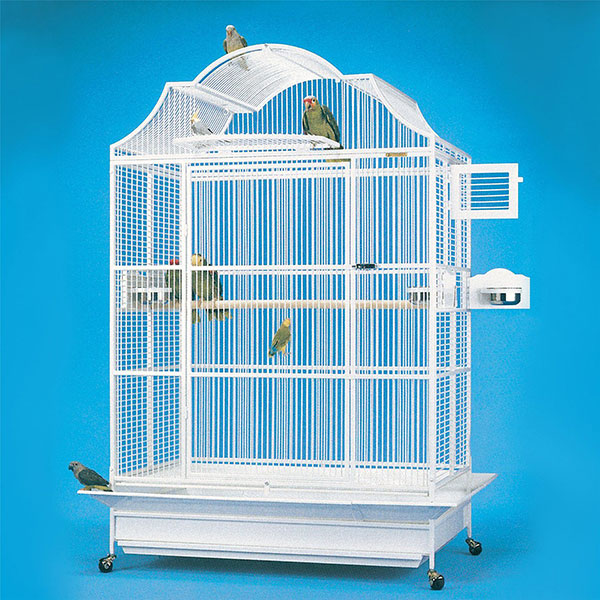
Larger bird require larger bird cage which are built to withstand their strong beaks and activity. Some of them have been known to undo bolts and locks and even dismantle their cages. For this reason, when choosing a bird cage for a bigger bird, be sure to get a quality cage. Trying to save money can result in purchasing another cage in a year or two. If this happens, then the cost of two cages may exceed the amount that would have been spent in buying the right cage in the first place.
Materials
Cages for mid to large sized birds, need to be stronger as well as larger. They must withstand the more powerful beaks and the activity of the birds. As a result, they are made of stronger materials and weigh a lot more. Depending upon size, cages for larger birds can weigh in the 160lb – 300lb range.
Larger cages are usually made of stainless steel or iron. Stainless steel is an excellent material for cages. It is strong, easier to clean, has no danger of paint chipping off and looks well. Unfortunately, even though prices have been declining recently, stainless steel cages are still quite expensive.
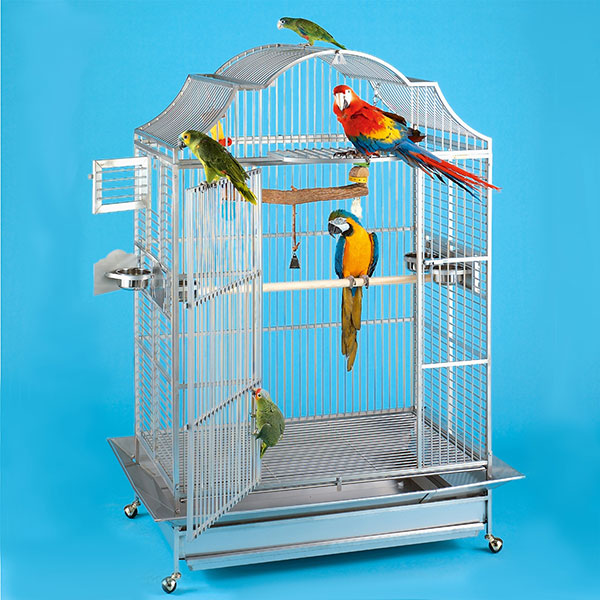
Cages made of iron can rust if not properly protected by a paint finish. Quality iron cages use powder coated paint, a process which bonds the paint to the cage and prevents most flaking and rust. The paint finish should also have safe levels of lead and zinc to avoid any danger of toxic poisoning of birds in case of flaking. Remember that larger birds have strong beaks and some enjoy biting or hanging on the cage bars and frame. Avoid any iron cages without paint or those without a safe, powder coated paint finish.
Although acrylic cages, may be a choice for smaller birds and small bird aviaries, many people believe the current acrylic cages are not a good choice for larger birds. Birds like to climb and need places to secure a foot hold. Larger birds’ feet and beaks can more easily scratch the acrylic, making it unsightly and creating places for dirt and bacteria to collect. They require more work to clean and disinfect. Poor air exchange, which may promote growth of organisms, can also be a problem without a ventilating fan. There continue to be advances in the design of acrylic cages which are addressing these problems.
Construction of the bird cage
Look at the construction of the bird cage. The frames should be sturdy and not easily bendable. Check how the bars are attached to the frame. Bars should be firmly welded to the frame. The welds should be strong and not easily broken when putting stress on the cage. This provides sturdiness and stability for the cage. Remember that large cages are heavy and the frame and bars must support a lot of weight and stress from use.
For non-stainless cages, check that the powder coating finish covers all parts of the cage, including the undersides and trays, which may get wet and rust or which the bird can reach.
Some manufacturers of iron cages use frames containing hollow corner and/or bottom posts in which holes are drilled to accept the bars. If these are not welded at each join, then water can get inside at these points and rust the cage from inside out. Even though the bird cage is powder coated, the paint can separate from the joins during use or movement, and water can begin entering the frame, especially during cleaning. Additionally, such separations are areas for dirt to enter and bacteria to grow. Beware of any cage which includes a label on it containing a warning about washing the cage.
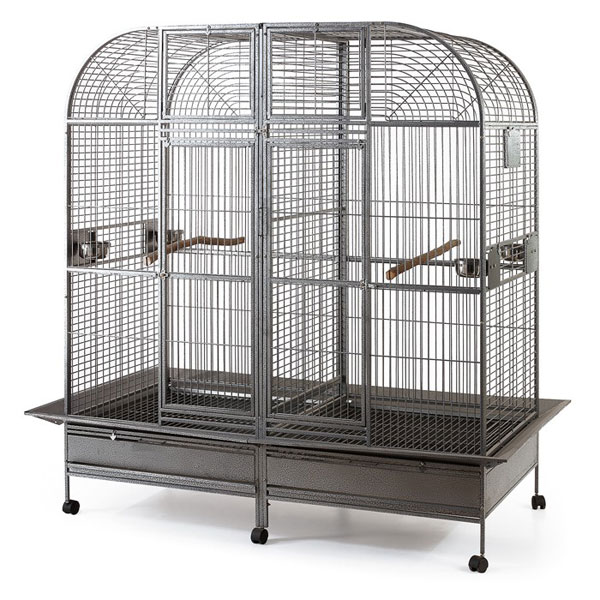
The cage bars provide support for the cage and solidify the frame. Cages for mid to large birds need to be sturdier. As a general rule, the wider apart the bars, the thicker they need to be. Bar spacing on a cage with bars 6mm thick can be wider than one with 4mm thick bars. The quality of the frame, the way the bars are attached to it and the strength of the materials used also affect the minimum safe bar spacing. Because of their strong beaks, the larger birds should have cages with 6mm bars. This is one area where manufacturers of inexpensive cages can save money, so be sure to check the bars.
Be sure that there a no sharp edges which can cause cuts. Also check for decorations. These may make the cage prettier, but be sure the bird cannot wedge a foot, head or wing in them. Make sure that decorations are welded firmly and won’t break off.
Check the inside of the cage frame where the sides meet the bottom. Are there many areas which will collect debris and be difficult to clean? All cages require some work to keep clean and free from bacteria, but cage design can help.
The cage should have a bottom tray as well as a grate. The grate should be high enough above the tray so that the bird cannot reach through it to the bedding and refuse in the tray. Better cages are made with slide out trays and grates to aid in cleaning the cage.
The cage should have casters so that it may be easily moved for cleaning. If selecting a cage which sits on a stand, then be sure the stand has casters. Casters should be large enough so that the weight is spread and the cage won’t leave indentations on the floor.
It is often necessary to reach deeply into the cage, either to retrieve a bird or position perches and toys. Look for a large door opening.
Also be sure that the cage can be easily taken apart. Larger cages often do not fit through doorways. It may need to be moved to another room or broken down for periodic thorough cleaning. If bolts are used to secure the various parts of the frame, then be sure that the nuts are on the outside. Unscrewing bolts are a favorite pastime of many of the larger species of birds.
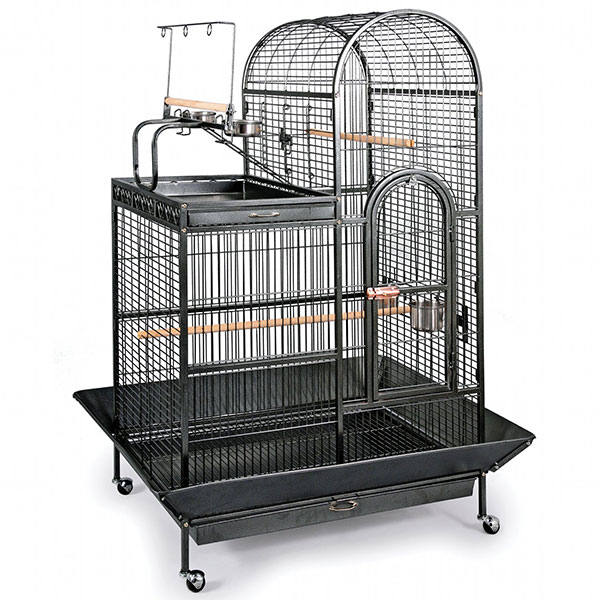
Ask about the manufacturer. Are spare parts available in case something gets broken or you want additional items such as extra trays or bowls. Does the manufacturer have a reputation for standing behind its products?
Bar Spacing
Spacing between the bars is also important for the safety of the bird. You want to be sure that he cannot wedge his head between the bars, get caught and then not be able to remove his head. Get a cage with a bar spacing too narrow to allow this. You also want to be sure that the spacing is not too wide. With larger birds this is not usually a problem, but smaller birds can squeeze through cage bars which are too far apart. Although we wouldn’t have believed it possible, we have seen our little conure squeeze through a cage with 5/8″ bar spacing. For mid to large size birds, bar spacing should be 3/4″ – 1 1/2″. Large birds such as macaws and cockatoos do well in cages with 6mm bars spaced farther apart.
Horizontal vs Vertical Bars
Cages come with all horizontal bars, all vertical bars and combinations of the two. Vertical bars provide strong support, especially for the heavy tops of larger cages and are preferred for the front which should have a large door opening in it.
Openings for feeder doors and breeder boxes are shorter. If they are placed among horizontal bars in a cage, they create less disturbance to the structure. Horizontal bars also make climbing and attaching dishes, perches and toys easier.
When choosing a larger cage, try to get one with at least some vertical bars for strength and stability. A combination of both vertical and horizontal is a good choice. Many cages are made with vertical fronts and backs and horizontal sides.
Bird Cage Shape
Cages are usually rectangular, but there are many variations in the shape of the cage top – flat, domed, pyramid, wavy, etc. The main consideration when choosing a style is how the bird will be using it.
Check the cage to see if the shape of the top hinders attaching toys or swings on the inside.
If the bird will spend time playing on the top of the cage, then will it be easy for the bird to stand on the top? Will poop be easily cleaned from the top of the cage and will poop fall on perches and toys below it in the cage?
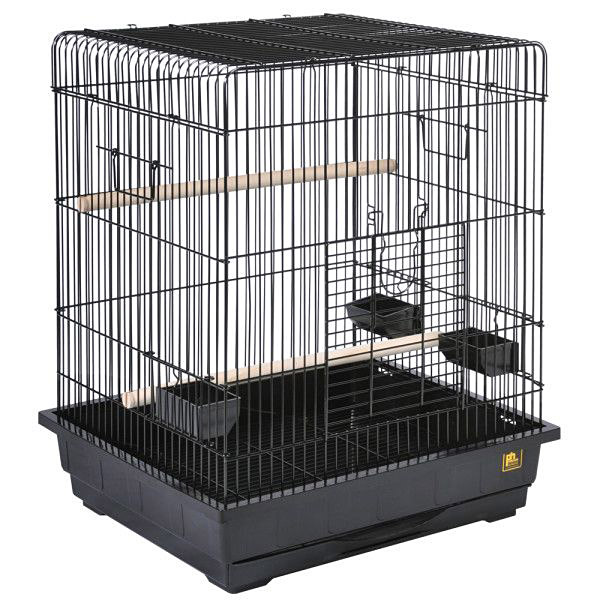
If you wish to place a playpen on top of the bird cage for the bird to play on, then you will want a top which is flat. Such playpens can also be moved to other locations, so that the bird can have a place to play in other areas of the home. The positive side is that playpens usually have a base which will catch droppings and thus help keep the cage clean. But, they also block out light and should be removed when not in use. The bottom of the playpen should also be checked for safety, if it is to be left on the cage when the bird is inside and if he can reach the underside of the playpen.
Some cages come with built in playpens or platforms which open and close, providing good flexibility. Some include extra perches and food cups. These models have tops of various shapes from flat to domed.
A model which fits on a stand, rather than a floor model, is often less expensive and may enable you to purchase one which is wider and deeper, providing more room for the bird to move around and better placement of perches and toys.
Although round cages are available, many people have expressed concerns that round cages are psychologically bad for parrots. It is believed that birds are uncomfortable without a side and/or corner to perch next to and spend a lot of time going in circles around the cage searching for a “secure” resting place.
Bird Cage Size
Birds spend a lot of time in their cages. They need to have room to extend and flap their wings, room to move about and jump from one perch to another, room to climb the bars, room for multiple perches and room to hang toys which don’t interfere with the above. Remember that birds are not only active and require exercise to keep their muscles in good condition, but they are also very intelligent and need toys, swings and perches to keep them from becoming bored and developing psychological problems. They also need toys and perches to chew upon to keep beaks trimmed, a natural behavior of birds. All of this requires space.
Purchasing a larger bird is expensive and many people try to save money by getting a smaller bird cage, unaware of their new pet’s needs. Some sellers tell new owners that a smaller cage is fine in order to make a sale. Imagine how you would feel if forced to spend much of your day standing on a single perch with little to do to amuse yourself. A healthy, happy bird makes a better pet than one which is squeezed into a too small bird cage and which consequently may develop behavioral or physical problems.
Choose a bird cage which is wider and deeper over one which is taller. This gives the bird more room to move around. A model which fits on a stand, rather than a floor model, is often less expensive and may enable you to purchase one which is wider and deeper.
Food Dishes and Doors
At least three food dishes are recommended, one for soft foods and treats, one for dry foods and one for water.
It is much easier to change food and water when there is access from the outside. You can avoid opening the main cage door and disturbing the bird if a cage has feeder doors which open for removing and filling the water and food dishes.
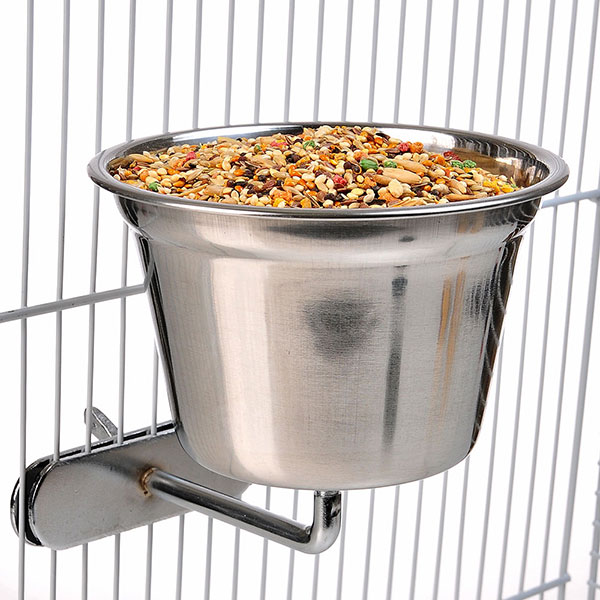
Birds are very intelligent and can often figure out how to remove and dump a food or water dish. Look for food dishes which have locking devices to protect them from being removed. Some feeder doors are also designed to prevent the bird from dislodging the cups when the doors are closed and don’t require cups with locking features. As a last resort, a thin rod of PVC pipe (which extends from one side of the cage to the other) can be placed an inch or two above the cups to prevent the bird from removing the dishes.
Also be sure that the bird cage has a bird proof lock on the main door. Birds are ingenious and can easily learn to open simple latches. The feeder doors need to be protected as well. Look for a design which the bird can’t reach from inside the cage (see above), which the bird won’t be able to open, or which has some type of effective lock.
Perches and Swings
There should be a number of perches of various thicknesses in the cage. Varying thicknesses help prevent development of foot problems. Natural branches are a good choice. Provide at least one manzanita, guava or other hard wood perch in the cage. These perches take a lot longer for the bird to destroy. Many people also recommend a cement perch to aid in keeping nails trimmed. If one is used, it should not be the perch the bird sleeps on. Avoid a sandpaper perch which is harmful to a bird’s feet. Many birds also enjoy a swing to play on.
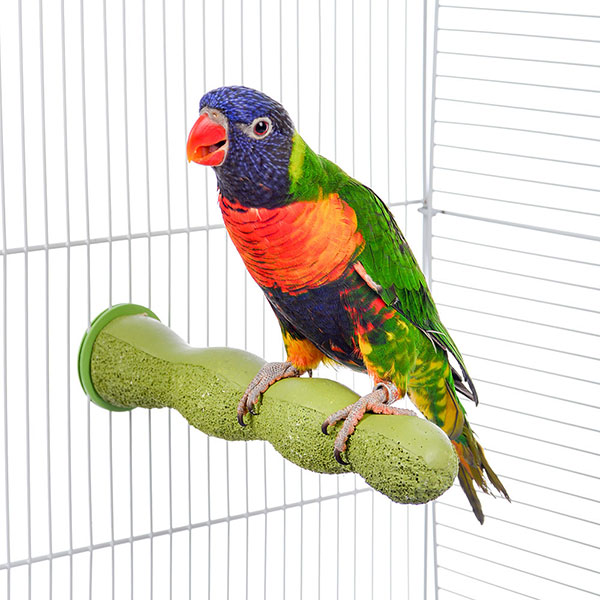
Place perches so that the bird can jump from one to another. But do not place them where the droppings can fall onto food bowls or other perches. Most birds like a high perch for sleeping, so place a comfortable wood perch towards the top, rear of the cage.
Other Features
Seed catchers are devices which surround the outside of the cage and are designed to catch food and debris. Birds are messy and often fling items out of the cage. A seed catcher can help, but be prepared to clean around the cages frequently. Getting a seed catcher on the bird cage is a matter of your personal preference.
Some cages come with built in breeder box doors. These can be opened so that a breeder box can be attached. Unless you are planning to breed your bird, these are not necessary. Further, if you are planning on breeding birds which have aggression issues, such as cockatoos, you will need a breeding box with 2 entrances. These will require cutting a 2nd hole in the cage.
When we purchased our cockatoo’s cage, we ordered an extra side panel for the cage. We cut additional openings in it which matched our breeder box openings. We can then switch the panels when breeding is desired. However, we are not professional breeders and have only one breeding pair. Professional breeders of larger birds use different types of cages or avairies for breeding. If you are planning on breeding, check with a good breeder.
In summary, be sure to buy a quality bird cage for mid to larger size birds. One which is sturdy, safe, roomy, durable and has the features you require for your bird. You will not regret it


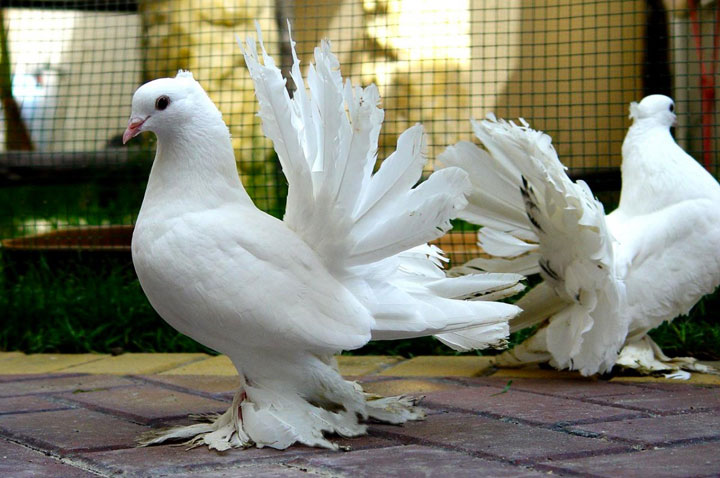

Leave a Reply